August 2009
Monthly Archive
Wed 19 Aug 2009
Posted by Steve under
ReviewsNo Comments
THE BACKWARD REVIEWER
William F. Deeck
WILL CREED – Death Comes Grinning. Five Star Mystery #47, digest-sized paperback original; 1st printing, 1946.
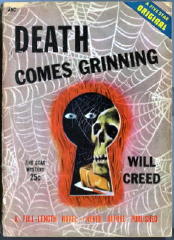
Oh, Pittsburgh’s the home of the steel mill,
The home of the rail and the rod;
Where the Cooks speak only to Bodemans
And the Bodemans speak only to God.
Yes, I know you’ve heard it with different names, but never mind. Sally Brown, recently graduated nurse, is hired to care for the relict of Cyrus Bodeman, who spoke, it would seem, more with Satan than God.
Brown is chosen because of her name, which implies to some person or persons unnamed, for reason or reasons unspecified, and in this case downright erroneously, plainness in appearance.
Why this is important the author sayeth not.
Bodeman’s widow is no prize, either, nor are her three sons. An unpleasant family, an unpleasant house, and Mrs. Bodeman has $100,000 in cash hidden away. She knows someone is trying to kill her for the money and the inheritance, so she gives Brown the key to the money box and names her in her will to get whatever else there is except the house.
Mrs. Bodeman likes Brown. It’s a good thing she didn’t hate her.
After the housekeeper dies suspiciously, Brown investigates. This requires her tasting a substance that could be strychnine and fortunately isn’t. She later, again voluntarily, drinks from a glass with a substance that could be strychnine and is. Two glasses of water drunk in quick succession, the popular and seemingly efficacious antidote to strychnine poisoning, save her for further folly.
This is primarily a suspense novel, as you will have noted, and not a very good one, as I will note for you.
Nobody gets the house or the money; Brown gets and deserves one of the Bodeman boys.
– From The MYSTERY FANcier, Vol. 10, No. 3, Summer 1988.
Editorial Comments: Will Creed was the pen name of author William Long. He wrote one other mystery novel under this name, that being Death Wears a Green Hat, which I reviewed here. I also appear to have liked the book I read more than Bill seems to have liked his.
As Peter Yates, Long wrote another four detective novels, all published by either Five Star Mystery or the closely related Vulcan line. (A full bibliography accompanies that earlier review.)
Wed 19 Aug 2009
Posted by Steve under
Reviews1 Comment
REVIEWED BY WALTER ALBERT:
PAUL WITCOVER – Dracula: Asylum. DH [Dark Horse] Press, softcover, 2006.

I recently read, and enjoyed, Barbara Hambly’s Renfield, a retelling of Stoker’s Dracula from the point of view of Renfield.
Now Paul Witcover has resurrected Renfield, who’s working as an orderly at the Carfax War Hospital, converted from its former use as a hospital for the insane to an institution hastily adapted (in 1916) to the treatment of victims of shell shock.
A young doctor (Lisa Watson) arrives at the hospital, ostensibly to work under the supervision of the director. She has, in fact, pulled strings to get the post, which will allow her access to her fiance who has lost his memory and imagines himself to be Sherlock Holmes.
Holmes/Watson? Well, that’s the level of the humor in this undistinguished novel, and pretty much the level of the invention.
As you might expect, Dracula, still lying in his coffin in nearby Carfax Abbey with a stake in his heart, will be resuscitated (by the hapless Renfield) and Dr. Watson will become Dracula’s prospective bride.
This is one in a series of novels that attempt to revive the classic Universal monsters. I would hope that the other novels in the series are more successful than this one.
Tue 18 Aug 2009
A MOVIE SERIAL REVIEW BY DAN STUMPF:
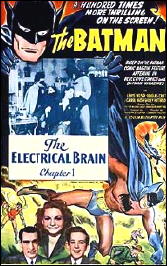
BATMAN. Columbia, 1943. [Fifteen-episode serial.] Lewis Wilson (Batman / Bruce Wayne), Douglas Croft (Robin / Richard ‘Dick’ Grayson), J. Carrol Naish, Shirley Patterson, William Austin (Alfred), Charles Middleton. Based on the DC Comic characters created by Bob Kane. Director: Lambert Hillyer.
Lightning Warrior [the 1931 Rin Tin Tin serial reviewed here ] was a gift from a friend, and it led to me watching a spate of serials, a pleasure I seldom indulge in because of the time consumed.
But shortly after this, I started on Batman (1943) which I hadn’t seen since a marathon evening back in 1965 when all 15 chapters were screened back-to-back, accompanied by witticisms hurled from the audience, for a campy event called An Evening With Batman And Robin.
Back then, Batman seemed closely linked to the myriad spy spoofs of the period but forty-odd years (in every sense) later, it has acquired a certain charm of its own.
The characters and their baroque machinations seem like brightly-painted toy soldiers marching about to the caprices of a wanton child, and all the fights, chases and explosions merely excuses for fun. Batman keeps starting fights he can’t finish, leading to This Week’s Cliff-Hanger, as the bad guys repeatedly beat him up, push him off a skyscraper, down an elevator shaft, from a cliff, under a speeding train or what-have-you.
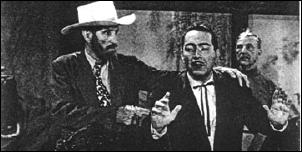
Lewis Wilson and Douglas Croft play the Dynamic Duo with admirably straight faces, and Charles Middleton livens up a few chapters as a colorful prospector, but J. Carroll Naish really steals the show with a hammy turn as the villainous Dr. Daka, complete with disintegrator ray, alligator pit, and an army of mindless zombies.
Not much sense in it, but there’s lots of fun.
Tue 18 Aug 2009
Posted by Steve under
ReviewsNo Comments
A REVIEW BY DAVID L. VINEYARD:
JOHN WELCOME – Stop at Nothing. Faber & Faber, UK, hardcover, 1959. Alfred A. Knopf, US, hc, 1960. Paperback reprint: Perennial Library P665, US, 1983.
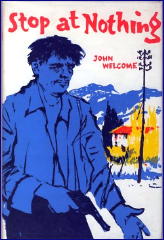
John Welcome was a British solicitor, anthologist, and novelist whose greatest claim to fame was that his list of clients included his long time friend Dick Francis. As an anthologist he edited a series of books such as Best Racing Stories and Best Secret Service Stories, that managed to reprint some less common stories than the usual retreads.
As a solicitor he is in a long tradition of mystery writers including John Buchan, Dornford Yates, and Michael Gilbert, and his novels all have some of the qualities of those writers.
Stop at Nothing is the second of his novels, and does not feature his series hero Richard Graham, a former steeplechase jockey. In this one the hero is Simon Herald, an amateur race driver (Formula One) who is a modern variation on the sportsman heroes of another age.
That said, Herald occupies a world much closer to ours than that of Richard Hannay. As the back cover of the Perennial paperback edition says:
“Pink champagne and barbiturates, Benzedrine for breakfast, and a glass of wine at Cap Ferat evoke the giddy glamour and insidious shadow of danger for Simon Herald …”
It’s the world of the Jet Set and Euro Trash, new money, jaded appetites, and casual drug use, and at forty, Simon Herald doesn’t really fit into it. Still he accepts an invitation to a party at Clevendon Court (one of the two genuine Robert Adam houses in Ireland) held by the wealthy Mantovelli.
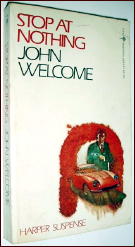
There he meets Roddy Marston, a young riding champion in a bad temper, Stuart Jason, a tough polished thug who works for his host (“he fell in love with violence during the war and can’t forget it”), and Mantovelli himself: “His face was seamed and wrinkled and scarred with lines of age, he had very bright blue eyes as hard as polished steel.”
An invitation to visit Mantovelli on his upcoming trip to France involves him with Roddy Marston’s sister, Sue, and finds him reluctantly helping the obnoxious Roddy as a result.
This is familiar thriller territory, and you shouldn’t expect any surprises along the way. This is the literary equivalent of a good blended Scotch, smooth but with an appreciable kick. Magnificent mountains in Provence, the beauty of the Riviera, and powerful Bentley’s, Rolls, Ferrari’s, and Aston Martin’s are the accouterments of people playing dangerous games with lives often above or beyond the reach of the law.
Simon Herald’s skill behind the wheel and his cool nerve make him the ideal man to negotiate these obstacles, and ultimately put pay to the nasty Mantovelli and his death-haunted henchman Jason.
The writing is accomplished and the plotting sure. Barzun and Taylor suitably praised it, though they did ask rather archly if you could actually see lights, much less breathe, from the presumably air-tight boot of an Aston Martin.
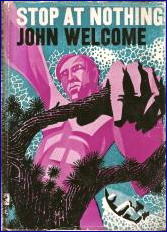
Still, minor things like that can be ignored when the thuggery is this sophisticated, the atmosphere this posh, and the derring-do starts on page one and doesn’t end until the last word on the last page.
Anthony Boucher called it “… lively, vivid, and highly readable…,” which is exactly what you can expect.
Welcome wrote several more novels, mostly international intrigue in this tradition with Richard Graham as the hero, as well as a good historical novel, Bellary Bay.
Almost all of them have the qualities of a good film, say Hitchcock in To Catch a Thief mode, nothing serious, but a kind of light and accomplished professional thriller that too few writers today seem capable of writing.
This is the perfect antidote to today’s bloated thrillers full of lunk-headed supermen and villains who wouldn’t pass muster in a bad comic book.
Stop at Nothing is the next best thing to visiting the Cote d’Azur and meeting a beautiful girl for a bit of romance and adventure and glamour and good life on your own, and a good deal less tiring and dangerous. It is what used to be meant by the term escapist.
At least, Welcome doesn’t have the hero drive from Gibraltar to Cannes in two hours like a certain geographically challenged best-selling thriller writer I recently encountered.
Oh for the days when thriller writers could actually read a map.
And write.
Tue 18 Aug 2009
A 1001 MIDNIGHTS Review
by Marcia Muller:
A. A. FAIR – Owls Don’t Blink. New York: William Morrow, hardcover, 1942. Paperback reprint: Dell 211, mapback, 1948. Many other reprint editions in both hardcover and soft.
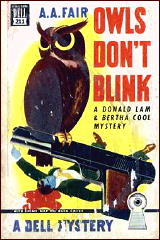
A. A. Fair is a pseudonym of Erle Stanley Gardner, but don’t pick up one of these novels featuring private eyes Bertha Cool and Donald Lam expecting a couple of carbon copies of Paul Drake.
Cool and Lam are an amusing and endearing pair — perfect foils for one another. Bertha Cool, at the time of this novel, is the middle-aged proprietor of an L.A. investigative firm, pared down to a mere 165 pounds but ever on the alert for a good meal. Her partner, Donald Lam, is a twerp in comparison — young, slender, and forever on the defensive for what Bertha considers excessive squandering of agency money.
But there’s considerable affection between the two, and with Donald doing the legwork, they crack some tough cases — and have a lot of fun while doing so.
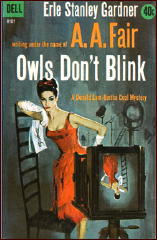
Owls Don’t Blink opens in the French Quarter of New Orleans, where Donald is occupying an apartment once rented by a missing woman he has been hired to find. He is due to meet Bertha at the airport at 7:20 the next morning and knows there will be hell to pay if he’s late.
Fortunately, he arrives on time, and together they meet the New York lawyer who has hired them to find Roberta Fenn, a former model. Over a number of pecan waffles — a number for Bertha, that is, who “only eats once a day” — the lawyer is evasive about why he wishes to locate Miss Fenn. But Cool and Lam proceed with the case — and Bertha proceeds with several lavish meals, still on that same day.
The discovery of the missing woman’s whereabouts proves all too easy, and also too easy is the discovery of a corpse in Roberta Fenn’ s new apartment. But from there on out, everything’s as convoluted as in the best of the Perry Mason novels.
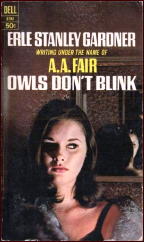
The scene moves from New Orleans to Shreveport, Louisiana, and from there to Los Angeles, where its surprising (although possibly a little out-of-leftfield) conclusion takes place.
And there’s a nice twist in the Cool-Lam relationship that will make a reader want to read the later entries in this fine series, such as Crows Can’t Count (1946), Some Slips Don’t Show (1957), Fish or Cut Bait (1963), and All Grass Isn’t Green (1970). Especially entertaining earlier titles are The Bigger They Come (1939) and Spill the Jackpot (1941).
———
Reprinted with permission from 1001 Midnights, edited by Bill Pronzini & Marcia Muller and published by The Battered Silicon Dispatch Box, 2007. Copyright © 1986, 2007 by the Pronzini-Muller Family Trust.
Mon 17 Aug 2009
Posted by Steve under
Reviews1 Comment
A. A. FAIR [ERLE STANLEY GARDNER] – Kept Women Can’t Quit.
Pocket 4602, paperback; 1st printing, February 1963; reprinted many times. Hardcover edition: William Morrow & Co., 1960.
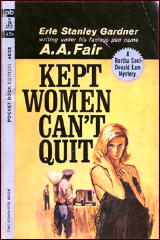
On the other hand [speaking recently about one of Anne Perry’s books], if you happen to discover a sense of continuity between one Erle Stanley Gardner book and the next, I’d say you were one heck of a bookhound.
In all honesty, Perry Mason and his crew did change over the years, but only gradually — from the early hard-boiled 30s books, to the 60s and 70s version that was greatly co-dependent on what Raymond Burr’s vast TV viewing audience saw. But if you were to read them in order, the books would be absolutely interchangeable, not that anyone cared, then or now.
And as far as Gardner’s other series is concerned, the one he worte as A. A. Fair, other than occasional glimpses of the outside world, Donald Lam and Bertha Cool, partners in a detective agency, never ever changed. He the brash younger partner, taking risks that continually exasperated loud, outspoken female half of the firm; and in tandem, consistently tormenting Sergeant Frank Sellars to utter blowing-his-top distraction.
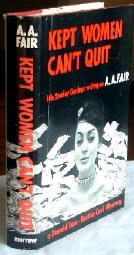
Gardner’s forte was never dialogue — once I learned of his usual practice of dictating his books to a steady supply of secretaries, that was it for me. From that point on, all of his characters talked the same way, and if I let myself slip away from the story, I could easily hear his voice instead of theirs.
(Something like listening to a vintage radio show and letting the curtain rise too soon, seeing the characters standing around a microphone, rather than listening to their voices as they hack their way through a jungle wilderness or travel cross-continent on on a fast-moving train full of would-be assassins.)
No, Gardner’s strong point was plotting, and there a point in Kept Women Can’t Quit when Donald Lam suddenly turns the case so far inside out that it makes you wonder what book it was that you were reading before then. At stake is $50,000 in stolen thousand dollar bills, and of course it is a good looking cutie with lots of curves who hires him.
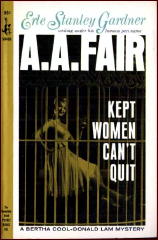
And yet. A couple of points puzzled me, and when I started to search back to double-check some reference points that I thought I might have missed, I discovered that when you start exploring what’s back of the curtain behind the magician and his waving hands, perhaps (once again) you’d rather you hadn’t.
It can be disappointing when you find out how much of Gardner’s plotting is really sleight-of-hand, that it’s all a facade. That while it’s not a fake, it’s all tied together with the flimsiest wisps of twine and plastered down with humongous amounts of duck tape.
In other words, Gardner probably made his plots too damned complicated for his own good. But for a reader who’s willing to extend him a license to deceive (me!) he’s still, and without a doubt, a Grand Master, one of the grandest of them all.
Mon 17 Aug 2009
Posted by Steve under
Reviews[5] Comments
FORGOTTEN MURDERS #2
by Allen J. Hubin
![ANONYMOUS [WYLIE] The Smiling Corpse](https://mysteryfile.com/blogImg809/Anon-Corpse.jpg)
ANONYMOUS – The Smiling Corpse. Farrar & Rinehart, hardcover, 1935.
This book is not notable for its great writing but for the unusual if not unique nature of the author’s approach.
The critic Wendel Hyat is guest of honor at a literary tea to celebrate the publication of his treatise on detective fiction, “From Poe to Plethora.” The gathering is peopled almost exclusively with famous persons, such as Tallulah Bankhead, Robert Benchley, Heywood Broun, James M. Cain, Clifton Fadiman, George Gershwin, Elsa Maxwell, Gene Tunney and dozens of others, all of whom are humorously identified in the Who’s Who at the beginning of the book.
Incidentally, a note in the Who’s Who states: “If any character in this book bears a resemblance in name or otherwise to any living person, it is sheer coincidence. None of the persons in this book is real.”
Hyat, who was diligently hated by everyone who knew him, is naturally discovered to be a smiling corpse. Among the guests at the tea are also G. K. Chesterton, Sax Rohmer, Dashiell Hammett and S. S. Van Dine. The author sets these men to solving the murder while behaving like their detective creations.
Cleric G. K. Chesterton tries not to overlook the obvious, Sax Rohmer suspects a sinister Chinese influence, Dashiell Hammett gets himself shot, and S. S. Van Dine overflows with erudition and says “deah man.”
As might be expected, none of these men is outstandingly successful in solving the crime, particularly since they operate under a certain ignorance about the actual instrument of death.
The author appears to have enjoyed himself in contriving this spoof, and it would seem that he had more than a nodding acquaintance with the works of the four mystery writers. Their characterizations, though naturally overdrawn, seem accurate enough.
The book made enjoyable reading, but its attraction lies in the intriguing and amusing possibilities of the contrived situations rather than any element of suspense. Here’s an interesting bibliographical puzzle: who was the anonymous author of this parody — an established author under his own name, or a timid unknown?
– From
The Armchair Detective, Vol. 1, No. 1, October 1967.
Editorial Update. 08-17-09. I’m not sure when it was discovered, but the authors of this rather desirable (and pricey) detective mystery are now known to be the co-writing tandem of Philip Wylie and Bernard A. Bergman. See, for example, this online bibliography for the first (and more well-known?) of the two authors.
Mon 17 Aug 2009
Now online, as of yesterday evening, is Part 34 of the Addenda to the Revised Crime Fiction IV, by Allen J. Hubin. While some revisions and corrections were still being made as of earlier this morning, it’s always a work in progress, and you’re certainly welcome to stop by and look around.
This installment may or may not appear in the 2009 version coming out soon on CD, but an announcement will be made here as soon as Bill Contento finishes it up and makes it available. As a text file this installment is a hefty 40 pages long, chock full this time with lots and lots of biographical information about older authors supplied by John Herrington.
Even though the coverage of the Revised Crime Fiction IV ends with the year 2000, it’s more and more obvious that while the flow of relevant information may slow down eventually, there’s no way it will ever stop coming in.
Sun 16 Aug 2009
A 1001 MIDNIGHTS Review
by George Kelley:
TED ALLBEURY – Shadow of Shadows. Charles Scribner’s Sons, hardcover, 1982. UK editions: Granada, hc, 1982; pb, 1982. (Shown is the cover of the paperback edition.)
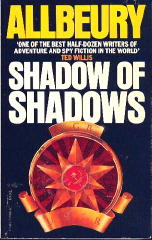
Ted Allbeury started writing espionage novels in the early 1970s. He specializes in realism and the sense of desolation evident in the best contemporary British spy fiction.
What makes Allbeury’ s novels so authentic is his background: He served with British counterintelligence during World War II. In each of the dozen espionage novels he has written so far, Allbeury creates characters and plots so convincing that the reader can’t help but be caught in his webs of suspense.
In Allbeury’ s best book to date, Shadow of Shadows, the game is a battle of wits between Colonel Anatoli Mikhailovich Petrov, a KGB defector, and British Intelligence’s James Lawler. Petrov has been supplying valuable information — identities of double agents, locations of “safe houses,” and more — until suddenly he stops talking.
Lawler’s mission is to find out who or what silenced Petrov and to convince him to resume supplying the vital information to British Intelligence.
Allbeury’s novelistic skills are apparent in the relationship between the two spies — one Russian, one British — who find they have more in common with each other than they do with the spy masters who control them. The relationship grows despite Petrov’s suspicion that Lawler’s real mission may be to discover his secrets and then to liquidate him.
With this novel and The Other Side of Silence (1981), Ted Allbeury has written espionage classics.
———
Reprinted with permission from 1001 Midnights, edited by Bill Pronzini & Marcia Muller and published by The Battered Silicon Dispatch Box, 2007. Copyright © 1986, 2007 by the Pronzini-Muller Family Trust.
Editorial Comment: My review of The Reaper, an earlier book by Ted Allbeury about tracking down ex-Nazis in Europe, along with some biographical data about the author, can be found here.
Sun 16 Aug 2009
A MOVIE SERIAL REVIEW BY DAN STUMPF:
THE LIGHTNING WARRIOR. Mascot, 1931. [Twelve-episode serial.] Rin Tin Tin, Frankie Darro, George Brent, Pat O’Malley. Georgia Hale, Theodore Lorch, Yakima Canutt. Directors: Benjamin H. Kline, Armand Schaefer.
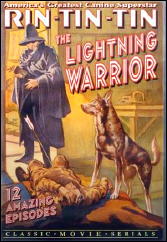
It’s hard to credit these days, but ninety-some years ago, Rin-Tin-Tin was a big star in the silent movies. Respectable critics lauded his emotional range, and even today hardened cynics like Walter Albert get all teary-eyed at the sight of him.
But that was in the Silent Movies. With the advent of the talkies, Rinty’s popularity diminished somewhat, and by the 1930s, with a couple of divorces behind him and a rumored dog-treat habit, he ended up doing serials at Mascot.
Not that The Lightning Warrior (1931) is all bad. I mean, sure it has an awkward script, stilted acting and meager budget … oftentimes the images seem murky, from Mascot’s policy of starting filming at first light of pre-dawn and not stopping till near-dark.
But it’s infused with that cheap energy typical of Mascot at its best, with vigorous stunting from Yakima Canutt, earnest playing from Frankie Darro, Betsy King Ross and George Brent (long before he met Bette Davis!) plus some truly fresh location work and the usual over-ambitious straining for effects way beyond its slender budget.
There’s a particularly neat bit with the principals jumping between ore carts from an old mine, suspended on a cable over a vertiginous chasm; not at all convincing, but you gotta give ’em credit for trying.
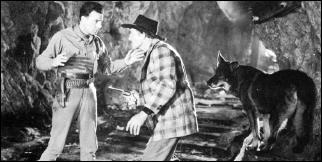
The plot, if there is one, even has some poetic overtones: something about an Indian Tribe that mysteriously vanished years ago, suddenly resurrected to terrorize a remote settlement at the behest of a black-cloaked figure known only as The Wolfman, whose appearances are announced by blood-curdling howls and … well, as the chapters go by, it develops that The Wolfman must actually be one of the townspeople, but which one? The Shifty Sherriff? The Mad Trapper? The Mysterious Stranger? Marvin Hamlisch? Dick Cheney?
Well, you needn’t look for clues, as everyone in the cast except Rinty takes turns looking guilty, and the last chapter reveals a solution that would strain the credulity of Harry Stephen Keeler, but it’s mostly fun along the way, and if Rinty gets no big emotional scenes, at least he (or his stunt-dogs) stay busy.
« Previous Page — Next Page »













![ANONYMOUS [WYLIE] The Smiling Corpse](https://mysteryfile.com/blogImg809/Anon-Corpse.jpg)


